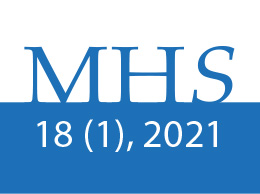Estado de Hidratación de Jugadoras de Fútbol Universitarias Durante Días de Entrenamiento y Partidos Consecutivos
DOI:
https://doi.org/10.15359/mhs.18-1.8Palabras clave:
fútbol, gravedad específica de la orina, hidratación, ingesta de líquidosResumen
Propósito: Se ha demostrado que la hidratación juega un papel fundamental en el deporte. El fútbol es un deporte de equipo en el que la integridad de todos los jugadores es vital para su rendimiento; por lo tanto, el estado de hidratación de cada jugador es importante. El objetivo principal de este estudio fue investigar el estado de hidratación de las jugadoras universitarias de fútbol durante la temporada regular.
Métodos: Dieciséis jugadoras universitarias de fútbol (edad: 20.4 ± 0.8 años; estatura: 163.6 ± 6.9 cm; peso: 65.3 ± 12 kg) proporcionaron muestras de orina durante 9 días para controlar su estado de hidratación, la cual se determinó por la gravedad específica de la orina (Usg). La Usg se analizó en la mañana (AM) y en la tarde antes del entrenamiento o el juego (PM).
Resultados: Las 16 jugadoras estaban al menos mínimamente hipohidratadas (Usg > 1.010) en la AM en 5 de los 9 días medidos. Las jugadoras tuvieron valores Usg significativamente más altos en AM en comparación con PM (F (1,250) = 23.09; p < 0.0001); sin embargo, no hubo interacción significativa de tiempo * día (F(1,250) = 1.98; p = 0.16).
Conclusión: los datos muestran una alta prevalencia de hipohidratación en esta población específica. Este estado de hidratación subóptimo podría ser motivo de preocupación en términos de rendimiento general. Se deberían hacer esfuerzos para integrar las intervenciones de hidratación y el monitoreo diario para reducir al mínimo la hipohidratación en las jugadoras.
Referencias
Adams, J. D., Kavouras, S. A., Johnson, E. C., Jansen, L. T., Capitan-Jimenez, C., Robillard, J. I., & Mauromoustakos, A. (2017). The Effect of Storing Temperature and Duration on Urinary Hydration Markers. Int J Sport Nutr Exerc Metab, 27(1), 18-24. https://doi.org/10.1123/ijsnem.2016-0098
Casa, D. J., Armstrong, L. E., Hillman, S. K., Montain, S. J., Reiff, R. V., Rich, B. S., Roberts, W., & Stone, J. A. (2000). National athletic trainers' association position statement: fluid replacement for athletes. J Athl Train, 35(2), 212-224. PMID: 16558633.
Castro-Sepulveda, M., Astudillo, J., Letelier, P., & Zbinden-Foncea, H. (2016). Prevalence of Dehydration Before Training Sessions, Friendly and Official Matches in Elite Female Soccer Players. J Hum Kinet, 50, 79-84. https://doi.org/10.1515/hukin-2015-0145
Chapelle, L., Tassignon, B., Aerenhouts, D., Mullie, P., & Clarys, P. (2017). The hydration status of young female elite soccer players during an official tournament. Journal of Sports Medicine and Physical Fitness, 57(9), 1186-1194. https://doi.org/10.23736/s0022-4707.16.06527-0
Edwards, A. M., & Clark, N. A. (2006). Thermoregulatory observations in soccer match play: professional and recreational level applications using an intestinal pill system to measure core temperature. British Journal of Sports Medicine, 40(2), 133-138. https://doi.org/10.1136/bjsm.2005.021980
Edwards, A. M., & Noakes, T. D. (2009). Dehydration: cause of fatigue or sign of pacing in elite soccer? Sports Medicine, 39(1), 1-13. https://doi.org/10.2165/00007256-200939010-00001
FIFA. (2019). Women’s Football MA’s Survey Report 2019. https://img.fifa.com/image/upload/nq3ensohyxpuxovcovj0.pdf
Gibson, J. C., Stuart-Hill, L. A., Pethick, W., & Gaul, C. A. (2012). Hydration status and fluid and sodium balance in elite Canadian junior women's soccer players in a cool environment. Appl Physiol Nutr Metab, 37(5), 931-937.https://doi.org/10.1139/h2012-073
Kilding, A. E., Tunstall, H., Wraith, E., Good, M., Gammon, C., & Smith, C. (2009). Sweat rate and sweat electrolyte composition in international female soccer players during game specific training. International Journal of Sports Medicine, 30(6), 443-447. https://doi.org/10.1055/s-0028-1105945
Logan-Sprenger, H. M., Heigenhauser, G. J., Killian, K. J., & Spriet, L. L. (2012). Effects of dehydration during cycling on skeletal muscle metabolism in females. Medicine and Science in Sports and Exercise, 44(10), 1949-1957. https://doi.org/10.1249/MSS.0b013e31825abc7c
Maughan, R. J. (2003). Impact of mild dehydration on wellness and on exercise performance. European Journal of Clinical Nutrition, 57 Suppl 2, S19-23. doi: https://doi.org/10.1038/sj.ejcn.1601897
Maughan, R. J., Merson, S. J., Broad, N. P., & Shirreffs, S. M. (2004). Fluid and electrolyte intake and loss in elite soccer players during training. Int J Sport Nutr Exerc Metab, 14(3), 333-346. https://doi.org/10.1123/ijsnem.14.3.333
McCambridge, J., Witton, J., & Elbourne, D. R. (2014). Systematic review of the Hawthorne effect: new concepts are needed to study research participation effects. Journal of Clinical Epidemiology, 67(3), 267-277. https://10.1016/j.jclinepi.2013.08.015
McDermott, B. P., Anderson, S. A., Armstrong, L. E., Casa, D. J., Cheuvront, S. N., Cooper, L., . . . Roberts, W. O. (2017). National Athletic Trainers' Association Position Statement: Fluid Replacement for the Physically Active. J Athl Train, 52(9), 877-895. https://doi.org/10.4085/1062-6050-52.9.02
McGregor, S. J., Nicholas, C. W., Lakomy, H. K., & Williams, C. (1999). The influence of intermittent high-intensity shuttle running and fluid ingestion on the performance of a soccer skill. Journal of Sports Sciences, 17(11), 895-903. https://doi.org/10.1080/026404199365452
Montain, S. J., & Coyle, E. F. (1992). Influence of graded dehydration on hyperthermia and cardiovascular drift during exercise. J Appl Physiol (1985), 73(4), 1340-1350. https://doi.org/10.1152/jappl.1992.73.4.1340
Murray, B. (2007). Hydration and physical performance. Journal of the American College of Nutrition, 26(5 Suppl), 542S-548S. https://doi.org/10.1080/07315724.2007.10719656
Osterberg, K. L., Horswill, C. A., & Baker, L. B. (2009). Pregame urine specific gravity and fluid intake by National Basketball Association players during competition. J Athl Train, 44(1), 53-57. https://doi.org/10.4085/1062-6050-44.1.53
Phillips, S. M., Sykes, D., & Gibson, N. (2014). Hydration Status and Fluid Balance of Elite European Youth Soccer Players during Consecutive Training Sessions. J Sports Sci Med, 13(4), 817-822.
Rothenberg, J. A., & Panagos, A. (2008). Musculoskeletal performance and hydration status. Curr Rev Musculoskelet Med, 1(2), 131-136. https://doi.org/10.1007/s12178-008-9020-9
Sawka, M. N., Burke, L. M., Eichner, E. R., Maughan, R. J., Montain, S. J., & Stachenfeld, N. S. (2007). American College of Sports Medicine position stand. Exercise and fluid replacement. Medicine and Science in Sports and Exercise, 39(2), 377-390. https://doi.org/10.1249/mss.0b013e31802ca597
Volpe, S. L., Poule, K. A., & Bland, E. G. (2009). Estimation of prepractice hydration status of National Collegiate Athletic Association Division I athletes. J Athl Train, 44(6), 624-629. doi: https://doi.org/10.4085/1062-6050-44.6.624
Descargas
Publicado
Cómo citar
Número
Sección
Licencia
Condiciones generales

MHSalud: Revista en Ciencias del Movimiento Humano y Salud por Universidad Nacional se encuentra bajo una Licencia Creative Commons Atribución-NoComercial-SinDerivadas 3.0 Costa Rica.
La revista se aloja en repositorios de acceso abierto como el Repositorio Institucional de la Universidad Nacional, el Repositorio Kimuk de Costa Rica y la Referencia.
La fuente editorial de la revista debe reconocerse. Para ello utilice el identificador doi de la publicación.
Política de autoarchivo: La revista permite el auto archivo de los artículos en su versión arbitrada, editada y aprobada por el Consejo Editorial de la Revista para que sean disponibles en Acceso Abierto a través de Internet. Más información en el siguiente link: https://v2.sherpa.ac.uk/id/publication/25815


















